
table of contents
- location claims
- Good coriander neighbors from A to D
- From E to K
- From L to P
- From R to Z
- frequently asked Questions
Coriander is found in many gardens and is a popular spice in Asian cuisine. The herb is cultivated as an annual and can easily be combined with many plants in mixed cultures. These are the best neighbors for cilantro.
In a nutshell
- preferably choose neighbors with similar location requirements
- Use coriander as underseed for perennial planting partners
- If possible, follow crop rotation with mixed crop partners
- Aphid infestation can be well prevented by suitable neighbors
location claims
There are many suitable neighbors for the coriander. When growing, it is important that you choose plants that have comparable requirements to the location as the coriander plants. This saves you a lot of work in the individual care of the cultures.
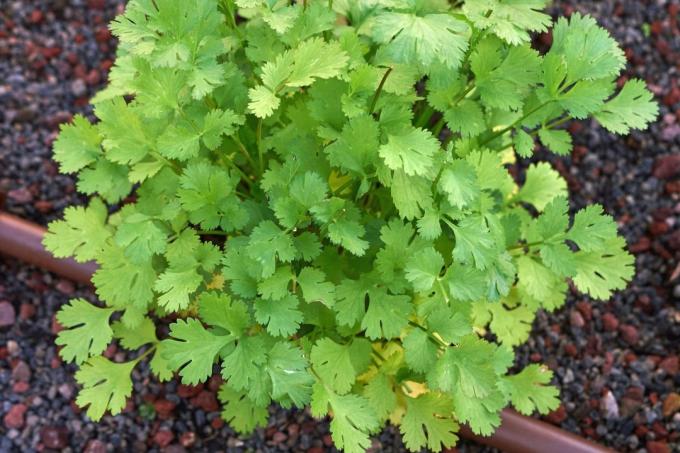
The coriander has the following location requirements:
- sunny and warm
- sheltered from the wind
- Plant coriander leaves in semi-shade
- permeable and loose soil
- calcareous soil preferred
- medium nutritional requirements
Good coriander neighbors from A to D
Anise (Pimpinella anisum)

Anise is not very demanding and has an intense aroma.
- Sowing time: May
- Spacing: 25 cm planting spacing, 30 cm row spacing
- Soil: humic, permeable, slightly calcareous
- Harvest: seed, herb
- Effect: attracts harmful insects, "sacrificial plant"
basil (Ocimum basilicum)

Basil is a bit more complex to grow because it needs light to germinate and ants like to carry the seeds away. A protected preculture is therefore ideal.
- Sowing time: mid-May
- Spacing: 10 to 15 cm between plants, 25 cm between rows
- floor: medium nutrient content, sandy, well-drained
- Harvest: from a height of about 15 cm, uppermost shoot tips
- Effect: protects against mildew, drives away harmful flies
borage (Borago officinalis)
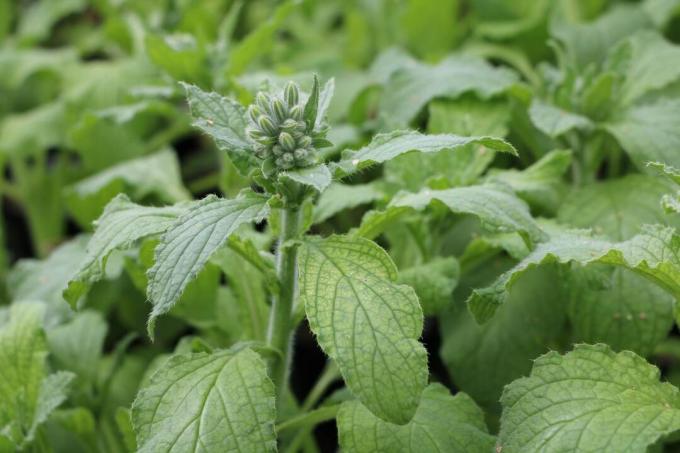
Borage is always a good partner when you want to harvest the seeds from the coriander plants. He attracts beneficial insects.
- Sowing time: April
- Spacing: 40 to 50 cm between plants, 35 to 45 cm between rows
- Soil: rich in nutrients, slightly moist, permeable
- Harvest: flowers, young leaves
- effect: attracts pollinators
Chili (Capsicum)
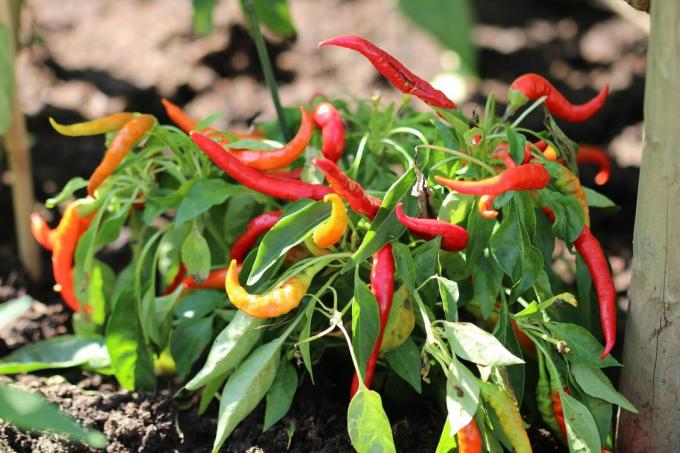
Chili gets along well with many plants, but is incompatible with other plants within the same nightshade family.
- sowing time: protected preculture depending on the variety from January
- Spacing: 40 to 50 cm between plants, 40 to 50 cm between rows
- Soil: rich in nutrients, slightly moist, loose
- Harvest: fruits from autumn
- Effect: prevents fungal infections
dill (Anethum graveolens)

Dill is a versatile plant, against various pests, but is itself susceptible to aphids.
- Sowing time: end of April
- Spacing: 15 to 20 cm between plants, 20 cm between rows
- Soil: rich in nutrients, loose, permeable
- Harvest: flowers, leaves
- Effect: repels moths and flies
Notice: Dill is an important forage crop for the swallowtail (Papilio machaon). Occasionally he may also go for other herbs in the immediate vicinity, such as coriander plants.
From E to K
tarragon (Artemisia dracunculus)
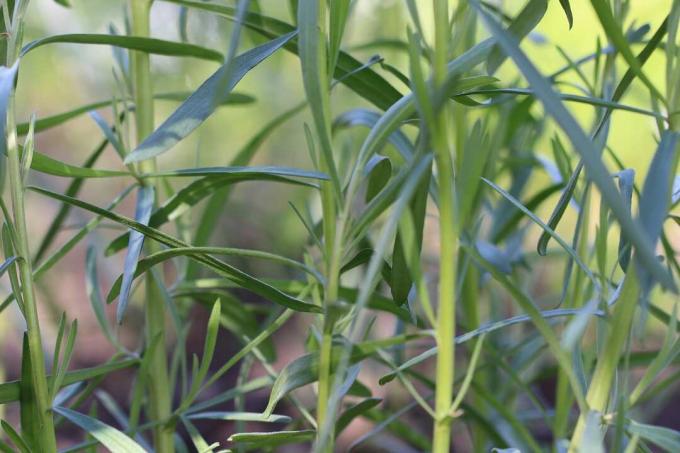
Tarragon is a perennial, which is why coriander plants are suitable as underplanting for it and not the other way around.
- Time of sowing: perennial, direct sowing from April
- Spacing: 30 cm planting spacing, 40 cm row spacing
- Soil: permeable, humic, slightly moist
- Harvest: young shoots
- Effect: similar location requirements, reduced value of harmful insects
Ginger (Zingiber officinale)

Ginger is exotic increasingly conquering domestic gardens and whose tuber is used as a spice.
- Time of sowing: Propagation via rhizomes from December
- Spacing: 20 cm planting spacing, 30 cm row spacing
- Soil: rich in nutrients, poor in lime
- Harvest: rhizomes in autumn
- Effect: prevents vole infestation
Chamomile (Matricaria chamomilla)

For many plants, chamomile is not a good neighbor. It can also be used to make pesticides that help against fungal diseases.
- Sowing time: March
- Spacing: 15 to 20 cm between plants, 30 to 40 cm between rows
- Soil: undemanding in terms of nutrient content, rather dry, deeply loosened
- Harvest: flowers
- Effect: Plant strengthening, protection against fungal infections
Nasturtium (Tropaeolum majus)
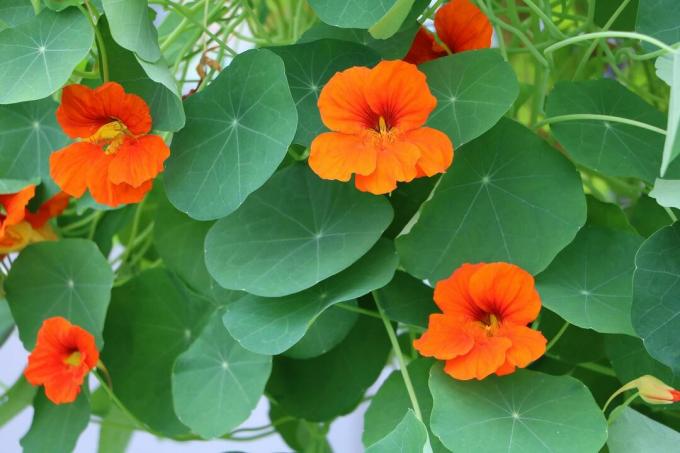
In the mixed culture, preferably use a low-lying variety of nasturtium. It is also a good groundcover that can shade the base of other plants.
- sowing time: May
- Spacing: 5 to 15 cm between plants, 30 cm between rows
- Soil: moderately nutritious, moderately humic
- Harvest: flowers, leaves
- Effect: attracts pollinators
chervil (Anthriscus cerefolium)
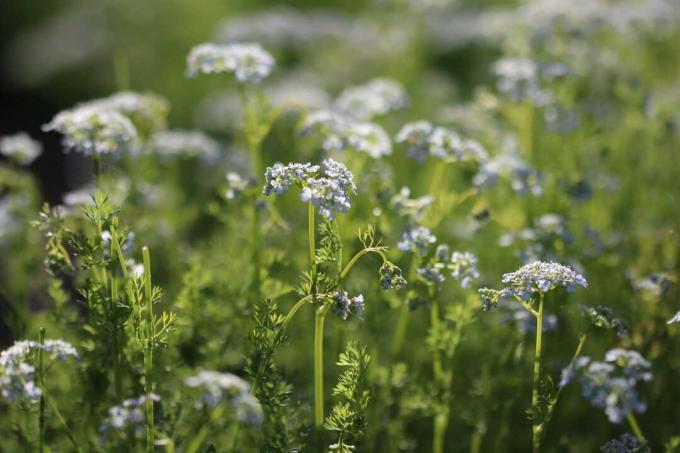
Umbelliferous plants such as chervil are only suitable as neighbors for coriander to a limited extent. However, they often have similar pollinators and thus support each other, but are often also susceptible to comparable diseases and pests.
- Sowing time: end of March
- Spacing: 10 to 15 cm between plants, 10 to 15 cm between rows
- Soil: loose, humic, slightly moist
- Harvest: leaves
- Effect: attracts pollinators
Cabbage (Brassica)
All types of cabbage are suitable as mixed culture partners for coriander. If you are dealing with tall varieties such as leafy cabbage, you should ensure that there is sufficient distance so that the coriander is not shaded.

- Sowing time: from the end of March (depending on the variety)
- Spacing: 20 to 50 cm between plants, 20 to 50 cm between rows (depending on variety)
- Soil: loose, humic, rich in nutrients
- Harvest: Leaves, flowers, shoots (depending on variety)
- Effect: mutually drive away harmful insects
From L to P
lovage (Levisticum officinale)

Although lovage is susceptible to aphids itself, it can ensure that other harmful insects do not attack the coriander plants.
- Sowing time: April
- Spacing: 50 cm planting spacing, 50 cm row spacing
- Soil: nutrient-rich, calcareous, moist
- harvest: Leaves
- Effect: drives away moths and flies
Notice: Lovage grows very large under optimal conditions. You should therefore always keep the planting distance.
marjoram (Origanum majorana)
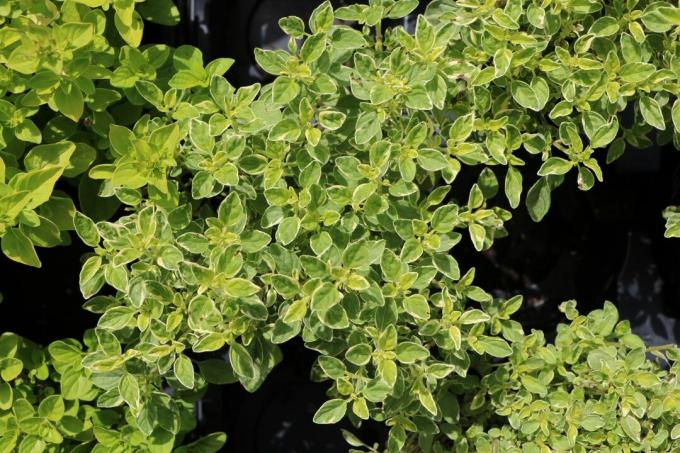
Although marjoram is perennial, it is sensitive to frost. It is therefore usually only cultivated once a year and is therefore an ideal partner for the coriander plants, which are also cultivated once a year.
- Time of sowing: Direct sowing from mid-May
- Spacing: 10 cm between plants, 25 to 30 cm between rows
- Soil: permeable, nutrient-rich, calcareous
- Harvest: young shoots
- Effect: drives away harmful insects
Notice: As an alternative to marjoram, perennial can also be used oregano (Origanum vulgare) to be sown next to the coriander. It has a similar effect and also attracts pollinators when it blooms.
mint (mentha)

Mints are easy to cultivate in the garden, but have the disadvantage that they spread quickly. It is therefore advisable to plant them with root barrier.
- Sowing time: mid-April
- Spacing: 30 cm planting spacing, 30 cm row spacing
- Soil: humic, rich in nutrients
- Harvest: young shoots, leaves
- Effect: drives away harmful insects such as whiteflies
Tip: Mint is also a good mulch when it becomes too overgrown in the garden. For this, it should be cut into small pieces and left to wilt for at least a day.
parsley (Petroselinum crispum)

As an annual culinary herb, parsley is an ideal cultural partner for coriander.
- Sowing time: end of April
- Spacing: 20 cm between plants, 20 to 30 cm between rows
- Soil: humic, rich in nutrients
- harvest: young shoots, leaves
- Effect: strengthens plants in case of aphid infestation
From R to Z
rosemary (Salvia rosmarinus)

The rosemary is only partially frost-resistant and should be overwintered in an unheated greenhouse. In the pot culture you can place it with the coriander and thus also benefit from the effects of the mixed culture.
- Sowing time: mid-April in a protected cold frame
- Spacing: 30 cm planting spacing, 40 cm row spacing
- Soil: humic, permeable
- harvest: Leaves
- Effect: repels harmful insects, limited fungicidal effect
sage (Salvia officinalis)

When sage is a regular pruning important so that he does not go bald.
- Sowing time: mid-May
- Spacing: 30 to 40 cm between plants, 35 to 40 cm between rows
- Soil: sandy, permeable, loose
- Harvest: young shoots, leaves
- Effect: repels harmful insects, as a mulch or decoction against fungal infections
yarrow (Achillea millefolium)

Yarrow is an underestimated plant in mixed cultivation. It can be combined with almost all herbs and vegetables that have comparable soil requirements.
- Sowing time: mid-April
- Spacing: 40 to 45 cm between plants, 40 to 45 cm between rows
- Soil: rich in nutrients, well drained, sandy
- Harvest: young shoots, leaves, flowers
- Effect: plant-strengthening effect
thyme (thymus)

In addition to the perennial Thymus vulgaris are particularly suitable for mixed cultures thyme varieties, which are annuals and are sown. In regions with severe frost, thyme rarely survives the winter and has to be sown again every year.
- Sowing time: mid-April
- Spacing: 30 cm planting spacing, 30 cm row spacing
- Soil: sandy, lean, permeable
- Harvest: young shoots
- Effect: prevention of fungal and bacterial infections
lemon balm (Melissa officinalis)

Lemon balm and coriander are not only good neighbors in the garden, they often end up in the pan together in Asian dishes.
- Sowing time: early/mid-May
- Spacing: 35 cm planting spacing, 35 cm row spacing
- Soil: loamy, nutritious, loose, permeable
- harvest: young shoots
- Effect: drives away harmful insects, flowers attract pollinators
frequently asked Questions
Bad neighbors for the coriander are, for example, the garden cress (Lepidium sativum) or fennel (Foeniculum vulgare). Chives are also unsuitable (Allium schoenoprasum) or winter hedge onion (Allium fistulosum) and chives (Allium ramosum).
Various bacterial and fungal diseases can cause problems for coriander. Powdery mildew (Erysiphe heraclei) is common. In addition, the plants also attack various rust fungi. Among the pests, aphids are targeting the plants. Occasionally, other harmful insects such as the carrot fly (Psila rosae) also occur, but these usually do not cause any major damage and can be repelled by a mixed culture.
The wilt is caused by the fungus Fusarium oxysporum caused. In order to prevent infection, it makes sense to change the location regularly and to keep to the crop rotation.
No, cilantro plants are not good neighbors to each other. In the row culture, there should also be another suitable species between the plants to reduce the transmission of diseases or pests.


